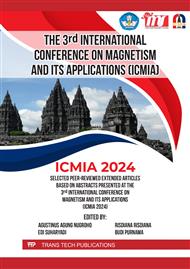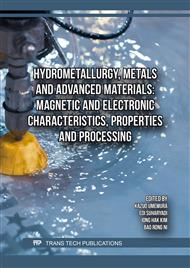[1]
A. K. Geim and K. S. Novoselov, "The rise of graphene," Nature Materials, vol. 6, p.183–191, Mar. 2007. Number: 3 Publisher: Nature Publishing Group.
Google Scholar
[2]
C. Lee, X. Wei, J. W. Kysar, and J. Hone, "Measurement of the Elastic Properties and Intrin- sic Strength of Monolayer Graphene," Science, vol. 321, p.385–388, July 2008. Publisher: American Association for the Advancement of Science.
DOI: 10.1126/science.1157996
Google Scholar
[3]
T. d. S. A. Cassiano, L. E. de Sousa, L. A. Ribeiro Junior, G. M. e. Silva, and P. H. de Oliveira Neto, "Charge transport in cove-type graphene nanoribbons: The role of quasiparti- cles," Synthetic Metals, vol. 287, p.117056, July 2022.
DOI: 10.1016/j.synthmet.2022.117056
Google Scholar
[4]
R. Siburian, S. Paiman, F. Hutagalung, A. M. M. Ali, L. Simatupang, R. Goei, and M. M. Rusop, "Facile method to synthesize of magnesium-graphene nano sheets for candidate of primary bat- tery electrode," Colloid and Interface Science Communications, vol. 48, p.100612, May 2022.
DOI: 10.1016/j.colcom.2022.100612
Google Scholar
[5]
H. Fan, Y. Li, D. Wu, H. Ma, K. Mao, D. Fan, B. Du, H. Li, and Q. Wei, "Electrochemical bisphenol A sensor based on N-doped graphene sheets," Analytica Chimica Acta, vol. 711, p.24–28, Jan. 2012.
DOI: 10.1016/j.aca.2011.10.051
Google Scholar
[6]
S. Chen, Y. Xu, C. Li, X. Xiao, and Y. Chen, "Modification of N-doped graphene films and their applications in heterojunction solar cells," Solar Energy, vol. 174, p.66–72, Nov. 2018.
DOI: 10.1016/j.solener.2018.08.083
Google Scholar
[7]
K. Nassiri Nazif, A. Daus, J. Hong, N. Lee, S. Vaziri, A. Kumar, F. Nitta, M. E. Chen, S. Kananian, R. Islam, K.-H. Kim, J.-H. Park, A. S. Y. Poon, M. L. Brongersma, E. Pop, and K. C. Saraswat, "High-specific-power flexible transition metal dichalcogenide solar cells," Na- ture Communications, vol. 12, p.7034, Dec. 2021. Publisher: Nature Publishing Group.
DOI: 10.1038/s41467-021-27195-7
Google Scholar
[8]
A. H. Castro Neto, F. Guinea, N. M. R. Peres, K. S. Novoselov, and A. K. Geim, "The electronic properties of graphene," Reviews of Modern Physics, vol. 81, p.109–162, Jan. 2009. Publisher: American Physical Society.
DOI: 10.1103/revmodphys.81.109
Google Scholar
[9]
R. M. Torres-Rojas, D. A. Contreras-Solorio, L. Hernández, and A. Enciso, "Band gap varia- tion in bi, tri and few-layered 2D graphene/hBN heterostructures," Solid State Communications, vol. 341, p.114553, Jan. 2022.
DOI: 10.1016/j.ssc.2021.114553
Google Scholar
[10]
E. Bhekti Yutomo, F. Arofiati Noor, and T. Winata, "Effect of the number of nitrogen dopants on the electronic and magnetic properties of graphitic and pyridinic N-doped graphene – a density- functional study," RSC Advances, vol. 11, no. 30, p.18371–18380, 2021. Publisher: Royal Society of Chemistry.
DOI: 10.1039/d1ra01095f
Google Scholar
[11]
D. Darminto, R. Asih, B. Priyanto, M. A. Baqiya, I. S. Ardiani, K. Nadiyah, A. Z. Laila, S. Prayogi, S. Tunmee, H. Nakajima, A. D. Fauzi, M. A. Naradipa, C. Diao, and A. Rusydi, "Un- revealing tunable resonant excitons and correlated plasmons and their coupling in new amor- phous carbon-like for highly efficient photovoltaic devices," Scientific Reports, vol. 13, p.7262, May 2023. Number: 1 Publisher: Nature Publishing Group.
DOI: 10.1038/s41598-023-31552-5
Google Scholar
[12]
W. Yang, Y. Zhang, J. Wang, M. Xia, J. Zhang, J. He, W. Guo, K. Tian, S. Liu, X. Li, G. Wang, and H. Wang, "Unprecedented 100% conversion from pyridinic to pyrrolic nitrogen configu- ration for electrochemically active nitrogen-doped carbon materials," Journal of Colloid and Interface Science, vol. 662, p.883–892, May 2024.
DOI: 10.1016/j.jcis.2024.02.107
Google Scholar
[13]
S. Wu, D. Wang, C. Liu, G. Fang, T.-R. Sun, P. Cui, H. Yan, Y. Wang, and D. Zhou, "Pyridinic- and Pyrrolic Nitrogen in Pyrogenic Carbon Improves Electron Shuttling during Microbial Fe(III) Reduction," ACS Earth and Space Chemistry, vol. 5, p.900–909, Apr. 2021. Publisher: Amer- ican Chemical Society.
DOI: 10.1021/acsearthspacechem.1c00012
Google Scholar
[14]
P. Lazar, R. Mach, and M. Otyepka, "Spectroscopic Fingerprints of Graphitic, Pyrrolic, Pyri- dinic, and Chemisorbed Nitrogen in N-Doped Graphene," The Journal of Physical Chemistry C, vol. 123, p.10695–10702, Apr. 2019. Publisher: American Chemical Society.
DOI: 10.1021/acs.jpcc.9b02163
Google Scholar
[15]
P. Giannozzi, S. Baroni, N. Bonini, M. Calandra, R. Car, C. Cavazzoni, D. Ceresoli, G. L. Chiarotti, M. Cococcioni, I. Dabo, A. D. Corso, S. d. Gironcoli, S. Fabris, G. Fratesi,R. Gebauer, U. Gerstmann, C. Gougoussis, A. Kokalj, M. Lazzeri, L. Martin-Samos, N. Marzari, F. Mauri, R. Mazzarello, S. Paolini, A. Pasquarello, L. Paulatto, C. Sbraccia, S. Scandolo, G. Sclauzero, A. P. Seitsonen, A. Smogunov, P. Umari, and R. M. Wentzcovitch, "QUANTUM ESPRESSO: a modular and open-source software project for quantum simulations of materials," Journal of Physics: Condensed Matter, vol. 21, p.395502
DOI: 10.1088/0953-8984/21/39/395502
Google Scholar
[16]
P. Giannozzi, O. Baseggio, P. Bonfà, D. Brunato, R. Car, I. Carnimeo, C. Cavazzoni, S. de Gironcoli, P. Delugas, F. Ferrari Ruffino, A. Ferretti, N. Marzari, I. Timrov, A. Urru, and S. Baroni, "Quantum ESPRESSO toward the exascale," The Journal of Chemical Physics, vol. 152, p.154105, Apr. 2020.
DOI: 10.1063/5.0005082
Google Scholar
[17]
J. P. Perdew, K. Burke, and M. Ernzerhof, "Generalized Gradient Approximation Made Sim- ple," Physical Review Letters, vol. 77, p.3865–3868, Oct. 1996. Publisher: American Physical Society.
DOI: 10.1103/physrevlett.77.3865
Google Scholar
[18]
N. Marzari, D. Vanderbilt, A. De Vita, and M. C. Payne, "Thermal Contraction and Disordering of the Al(110) Surface," Physical Review Letters, vol. 82, p.3296–3299, Apr. 1999. Publisher: American Physical Society.
DOI: 10.1103/physrevlett.82.3296
Google Scholar
[19]
P. E. Blöchl, O. Jepsen, and O. K. Andersen, "Improved tetrahedron method for brillouin-zone integrations," Phys. Rev. B, vol. 49, p.16223–16233, Jun 1994.
DOI: 10.1103/physrevb.49.16223
Google Scholar
[20]
D. Wu, X. Gao, Z. Zhou, and Z. Chen, "Understanding Aromaticity of Graphene and Graphene Nanoribbons by the Clar Sextet Rule," in Graphene Chem- istry, p.29–49, John Wiley & Sons, Ltd, 2013. Section: 3 _eprint: https://onlinelibrary.wiley.com/doi/pdf/.
DOI: 10.1002/9781118691281.ch3
Google Scholar
[21]
A. Avsar, H. Ochoa, F. Guinea, B. Özyilmaz, B. van Wees, and I. Vera-Marun, "Colloquium: Spintronics in graphene and other two-dimensional materials," Reviews of Modern Physics, vol. 92, p.021003, 2020.
DOI: 10.1103/revmodphys.92.021003
Google Scholar



